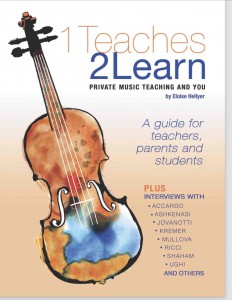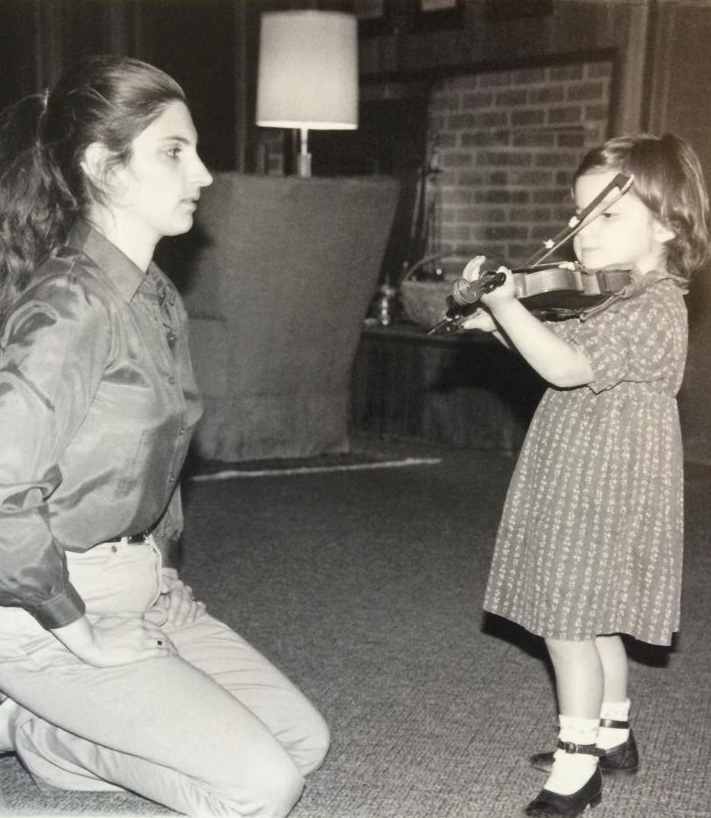1 Teaches 2 Learn—Private Teaching and You, A Guide for Teachers, Parents and Students
Here is the book (in ebook format downloadable everywhere in the world from Shar Music) I have written on the art of teaching. The title is a play on words of the phrase by Robert Heinlein, “When one teaches, two learn.” To me, it can also mean that one teaches in order to learn. In fact, everything in the text of the book is what I have learned from my students and their families. I owe them a great debt.
Over twenty years ago, a father of one of my students observed me teaching, told me he liked how I taught and that I should write a method book. Given that this father is a well-known film score composer, I was taken aback but, given his stature, I gave his idea some thought. He also suggested that I interview famous musicians to back me up. So I obediently started getting some interviews, began writing and, to my utter surprise, found out that I had a lot to say on the subject: the book is 260 pages of text and 200 pages of interviews—and that’s after editing (slashing and burning)!
All the interviews, except for the last two (Covid), were done in person. Skype wasn’t invented when I started, and in any case I like being face to face with my subjects. They were/are all fascinating and seemed pleased that I asked questions that no one had asked them before: their personal experiences as beginners, what their teachers were like, and lots of other very interesting topics that came up naturally as we spoke. Charles Avsharian, an accomplished violinist and CEO of Shar Music, told me he likes my journalistic style. I didn’t know I had one; my “style” is to try to ask an intelligent question, then shut up and let the interviewees talk. They told me some amazing things, and I think some of these eminent musicians—as well as I—were surprised where our conversations took us.
The central thesis of the book is that teaching is a spiritual activity, something not often discussed. In fact, I know of no moral, ethical or philosophical preparation of teachers, especially music teachers. Didactics is the study of methods, how children react to them and how children learn. How teachers teach and even what teaching really is, is quite another matter. I have attempted to broach these latter subjects.
The problem is that, unlike many other professions, musicians study to become musicians, invest a lot of time and money in it and then find out they are probably going to have to do something completely different: teach. As many quickly find out, knowing how to do something and knowing how to teach it are not the same thing. I don’t know the percentage, but I would guess that something like well over 90% of all classical musicians, even highly successful ones, wind up teaching at some point in their careers. Some make a career of teaching itself. For some it’s a calling, for others it’s something they do to make extra money in addition to their professional jobs, for still others it’s what they have to do to make enough money so they can play. Some already know they want to teach while others don’t want to but have to. I firmly believe that any of the above—indeed every one of them—can be a competent teacher, if not a great one, and at the very least do no harm. This book shows how, backed up with interviews recounting a few of teaching’s greatest and worst moments, if you read them carefully.
We all must realize that teaching is important and very powerful. We music teachers, accidental or intentional, must also recognize the power we have and be very careful how we use it. I think most of us can think back on some bad teaching we have had or have observed at some point in our student careers and remember the deleterious effect it may have provoked. We also need to be aware that we tend to teach how we were taught, whether badly or well, so this book may provoke a change of attitude. In any case, it’s always a good thing to hear other points of view on any subject, no matter how set in our ways (and perhaps rightly so) we may be.
In the book are lots of practical pieces of advice, learned from decades of experience: the sort of things “if I had know then what I know now,” which I hope will be of help to teachers as well as students and parents (including how to pick a teacher for your child or even yourself) to whom there are also devoted two chapters, although there’s a lot for them in other chapters as well. The idea is to save time for younger teachers (and parents and students) instead of taking a whole lifetime to learn many of the things in this book, as I had to. Experience can be had in two ways: personal and direct, or by learning from the experience of others: a shortcut. I hope you all enjoy reading about the experiences that formed my “philosophy” and teaching and those of the various and fascinating interviewees.
Eloise Hellyer
Share this:
Buy it on www.sharmusic.com - eBook format, avaliable worldwide, paperback in North America
COPYRIGHT
ABOUT
A music teacher’s thoughts and observations on the teaching and the study of a musical instrument, hoping to be of help to parents, students and teachers.
PHOTO
AWARDED TOP 25 VIOLIN BLOG
CATEGORIES
TAGS
ARCHIVES
-
Agosto 2022
Agosto 2023
Agosto 2024
April 2015
April 2016
April 2017
April 2019
April 2020
Aprile 2022
Aprile 2023
Aprile 2024
August 2014
August 2015
August 2016
August 2017
August 2018
August 2019
August 2021
December 2014
December 2015
December 2016
December 2017
December 2018
December 2019
December 2020
Dicembre 2022
Dicembre 2023
Dicembre 2024
Febbraio 2022
Febbraio 2023
Febbraio 2024
February 2015
February 2016
February 2018
February 2019
February 2020
February 2021
Gennaio 2022
Gennaio 2023
Gennaio 2024
Giugno 2022
Giugno 2022
Giugno 2023
Giugno 2024
January 2015
January 2016
January 2017
January 2018
January 2019
January 2020
July 2015
July 2017
July 2019
June 2016
June 2017
June 2018
June 2019
June 2020
June 2021
Luglio 2022
Luglio 2023
Luglio 2024
Maggio 2022
Maggio 2023
Maggio 2024
March 2015
March 2016
March 2017
March 2018
March 2019
March 2020
March 2021
Marzo 2022
Marzo 2023
Marzo 2024
May 2015
May 2016
May 2018
May 2019
May 2020
November 2014
November 2015
November 2016
November 2017
November 2018
November 2019
November 2021
Novembre 2022
Novembre 2023
Novembre 2024
October 2014
October 2015
October 2017
October 2018
October 2019
October 2020
October 2021
Ottobre 2022
Ottobre 2023
Ottobre 2024
September 2014
September 2015
September 2016
September 2018
September 2019
September 2020
September 2021
Settembre 2022
Settembre 2023
Settembre 2024
RECENT POSTS
Terry G and Me, or Terry Gilliam on Where (or What) Practicing the Piano Will Get You…
The Teaching We Don’t Do Is More Important Than We Think
Overwhelmingness or What Teaching and Motherhood* Have in Common
Cellphone Serenity
How to Build Your Reputation – the Kind You Want
Desperate Times, Desperate Measures. Or How to Deal With Your Strong-Willed Stubborn Student and Survive
“Why Does My Teacher Get So Frustrated?” Letter to a Perplexed Student
Mount Rush-no-more….And How to Get There
Realizzato con VelociBuilder - Another Project By: Marketing:Start! - Privacy Policy




